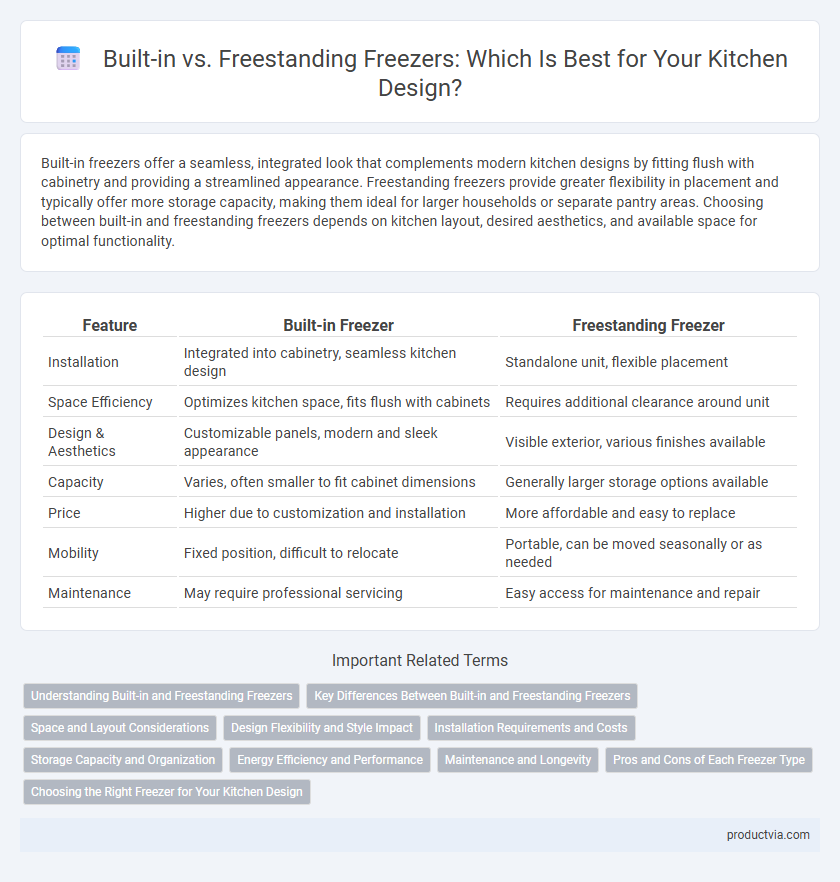Built-in freezers offer a seamless, integrated look that complements modern kitchen designs by fitting flush with cabinetry and providing a streamlined appearance. Freestanding freezers provide greater flexibility in placement and typically offer more storage capacity, making them ideal for larger households or separate pantry areas. Choosing between built-in and freestanding freezers depends on kitchen layout, desired aesthetics, and available space for optimal functionality.
Table of Comparison
| Feature | Built-in Freezer | Freestanding Freezer |
|---|---|---|
| Installation | Integrated into cabinetry, seamless kitchen design | Standalone unit, flexible placement |
| Space Efficiency | Optimizes kitchen space, fits flush with cabinets | Requires additional clearance around unit |
| Design & Aesthetics | Customizable panels, modern and sleek appearance | Visible exterior, various finishes available |
| Capacity | Varies, often smaller to fit cabinet dimensions | Generally larger storage options available |
| Price | Higher due to customization and installation | More affordable and easy to replace |
| Mobility | Fixed position, difficult to relocate | Portable, can be moved seasonally or as needed |
| Maintenance | May require professional servicing | Easy access for maintenance and repair |
Understanding Built-in and Freestanding Freezers
Built-in freezers integrate seamlessly into kitchen cabinetry, offering a streamlined and cohesive aesthetic that enhances modern kitchen designs. Freestanding freezers provide versatile placement options and are typically less expensive, making them suitable for various kitchen layouts and budgets. Understanding the distinctions in installation, size options, and ventilation requirements helps homeowners choose the ideal freezer type to complement their kitchen design and functionality.
Key Differences Between Built-in and Freestanding Freezers
Built-in freezers offer a seamless integration with cabinetry, providing a streamlined, custom look that matches kitchen design, while freestanding freezers are standalone units that allow flexible placement and easier installation. Built-in models typically have a flush mount design and can be more expensive due to customization and installation costs, whereas freestanding freezers are generally more affordable and portable. Built-in freezers often provide better insulation and energy efficiency because of their fixed positioning, contrasting with the varied energy ratings and ventilation needs of freestanding units.
Space and Layout Considerations
Built-in freezers offer a seamless integration into kitchen cabinetry, optimizing space and maintaining a streamlined layout ideal for modern kitchens with limited floor area. Freestanding freezers provide flexibility in placement, suitable for larger kitchens or utility rooms where space constraints are minimal and accessibility is prioritized. Considering kitchen dimensions and workflow patterns is crucial for choosing between built-in models that save space and freestanding units that offer movable convenience.
Design Flexibility and Style Impact
Built-in freezers offer seamless integration with cabinetry, providing a sleek and uniform look that enhances modern kitchen aesthetics and maximizes design flexibility. Freestanding freezers allow for easier relocation and come in various styles and sizes, making them ideal for versatile kitchen layouts but may disrupt cohesive design flow. Choosing between built-in and freestanding freezers directly impacts kitchen style, with built-ins favoring minimalist elegance and freestanding models supporting practical adaptability.
Installation Requirements and Costs
Built-in freezers require professional installation with customized cabinetry integration, increasing overall kitchen renovation costs but offering a seamless, flush appearance ideal for modern design. Freestanding freezers are more cost-effective, requiring minimal installation and flexibility in placement, though they may disrupt kitchen flow due to their protruding design. Choosing between the two depends on balancing upfront installation expenses against aesthetic goals and available space.
Storage Capacity and Organization
Built-in freezers offer seamless integration with kitchen cabinetry, providing customizable storage solutions that maximize space efficiency through adjustable shelves and drawers suited for diverse food items. Freestanding freezers typically provide larger storage capacity and flexibility in placement but may lack the tailored organizational features of built-in models. Prioritizing storage capacity and organization helps optimize kitchen workflow and ensures preservation of various frozen goods based on individual household needs.
Energy Efficiency and Performance
Built-in freezers typically offer better energy efficiency due to their seamless integration and superior insulation, reducing energy loss compared to freestanding models. Freestanding freezers provide flexibility in placement and are easier to replace but may consume more energy due to less effective sealing. Performance-wise, built-in freezers maintain more stable internal temperatures, enhancing food preservation quality and reducing operating costs over time.
Maintenance and Longevity
Built-in freezers typically require less maintenance due to their integrated design, which reduces dust accumulation and allows for consistent temperature control, enhancing longevity. Freestanding freezers offer easier access for cleaning and repairs but may need more frequent defrosting to maintain optimal efficiency. Choosing a built-in model can extend appliance lifespan through better insulation and stable operating conditions in a well-ventilated kitchen space.
Pros and Cons of Each Freezer Type
Built-in freezers offer a seamless integration into kitchen cabinetry, providing a sleek, customized look and saving floor space, but they typically come with a higher price tag and more complex installation requirements. Freestanding freezers provide greater flexibility in placement, larger storage capacity, and easier installation, although they may disrupt the kitchen's design flow and occupy more usable space. Considering energy efficiency, built-in models often feature better insulation due to their fixed position, while freestanding units tend to be more versatile for various household needs.
Choosing the Right Freezer for Your Kitchen Design
Choosing the right freezer for your kitchen design depends on available space, aesthetic preferences, and functional needs. Built-in freezers offer a sleek, integrated look that maximizes space and complements cabinetry, while freestanding freezers provide flexibility in placement and often come with a larger storage capacity. Considering factors such as kitchen layout, ventilation requirements, and budget ensures an optimal choice that enhances both utility and design harmony.
Built-in vs Freestanding Freezer for Kitchen Design Infographic

 productvia.com
productvia.com